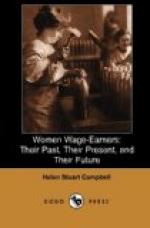In the nail and chain making districts of England, Sundays are often abolished where these furnaces flame, and such rest as can be stolen comes on the cinder-heaps. But these workers are few compared with the myriads who must battle with the most insidious and most potent of enemies,—the dust of modern manufacture. There is dust of heckling flax, with an average of only fourteen years of work for the strongest; dust of emery powder, that has been known to destroy in a month; dust of pottery and sand and flint, so penetrating that the medical returns give cases of “stone” for new-born babes; dust of rags foul with dirt and breeding fever in the picker; dust of wools from diseased animals, striking down the sorter. Wood, coal, flour, each has its own, penetrating where it can never be dislodged; and a less tangible enemy lurks in poisonous paints for flowers or wall-paper, and in white lead, the foundation of other paints,—blotching the skin of children, and ending for many in blindness, paralysis, and hideous sores.
This is one form; and side by side with it comes another, dealt with here and there, but as a rule ignored,—vapors as deadly as dust; vapors of muriatic acid from pickling tins; of choking chlorine from bleaching-rooms; of gas and phosphorus, which even now, where strongest preventives are used, still pull away both teeth and jaws from many a worker in match-factories; while acids used in cleaning, bleaching-powders, and many an industry where women and children chiefly are employed, eat into hands and clothing, and make each hour a torture.
With the countless forms of machinery for stamping and rolling and cutting and sawing, there is yet, in spite of all the safeguards the law compels, the saying still heard in these shops: “It takes three fingers to make a stamper.” Carelessness often; but where two must work together, as is necessary in tending many of these machines, the partner’s inattention is often responsible, and mutilation comes through no fault of one’s own. Add to all these the suffering of little children taught lace-making at four, sewing on buttons or picking threads far into the night, and driven through the long hours that they may add sixpence to the week’s wage, and we have a hint of the grewsome catalogue of the human woe born of human need and human greed.
For the United States there is a steadily lessening proportion of these evils, and we shall deal chiefly with those found in existence by the respective bureaus of labor at the time when their investigations were made. Private and public investigation made before their organization had brought to light in Connecticut, and at many points in New England, gross abuses both in child labor and that of woman and girl workers. It is sufficient, however, for our purpose to refer the reader to the mention of these contained in the first report of the Massachusetts Bureau of Labor, as well as to Dr. Richard T. Ely’s “History of the Labor Movement in America,” and to pass at once to the facts contained in the fifteenth report from Massachusetts.




